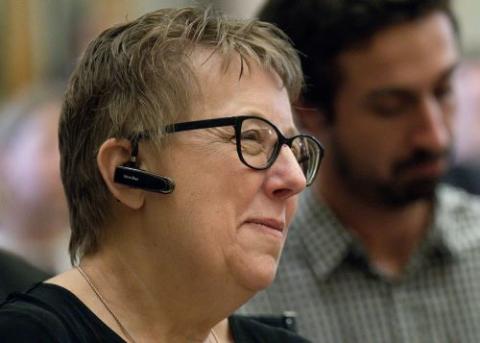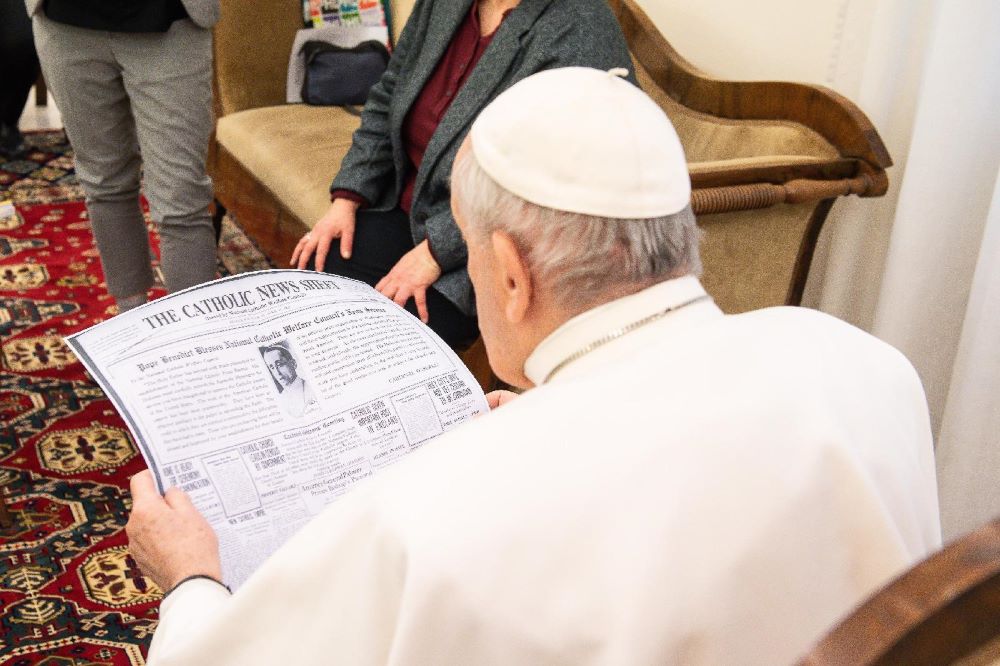This is the front page of an issue of Catholic New York, newspaper of the Archdiocese of New York, which published its last issue Nov. 17, 2022. A few weeks later, the archdiocese launched its digital outlet, The Good Newsroom. (CNS/Tyler Orsburn)
Earlier this month, the Peoria Diocese in Illinois announced it had closed its diocesan newspaper, to be replaced with eventual "new strategies in a wider communications plan," according to its bishop.
What "plays in Peoria," however, is already part of a trend unlikely to slow: Bishops are cutting print publications or shuttering operations altogether, only to replace diocesan newspapers with soft-news magazines, websites and public relations content. Meanwhile, new online, niche and sometimes ideological Catholic media are filling the gap.
The cuts to local Catholic media reflect wider journalistic trends of financially motivated decisions. The week after Peoria's announcement, the Los Angeles Times laid off more than 20% of its newsroom, and Sports Illustrated announced it was terminating "almost all" its staff — leading one commentator to call it "a week from hell in media."
Catholic media — especially diocesan papers that provide local coverage and often serve as the vehicle for a bishop's regular column — are not exempt from the larger forces affecting journalism, experts say. In addition, they are negatively impacted by the decline in religious affiliation and participation in the U.S. and by competition from new Catholic media.
'One of the main reasons you had a diocesan newspaper was to serve as the voice of the bishop. He doesn't need that anymore, for good or for ill.'
—David Gibson
In fact, the Peoria paper wasn't the only diocesan publication to cease operations at the end of 2023. The Diocese of Green Bay, Wisconsin, whose first Catholic newspaper dates to the 19th century, published the last issue of The Compass at the end of December. A year earlier, the country's largest diocesan newspaper, Catholic New York, shut down, just as the U.S. bishops' conference closed its national operations of Catholic News Service. Other recent closures include Seattle's paper in 2013, Akron's in 2015 and Detroit's in 2018.
The number of Catholic newspapers in the U.S. dropped from 196 in 2006 to 118 in 2020, according to the Catholic Media Association. The organization's current directory lists 84 newspapers as members.
"We need to take a step back and look at why this is not working," said Helen Osman, president of SIGNIS, the World Catholic Association for Communication. "This goes beyond just Catholic journalism. In this country we have so devalued the idea of local journalism that we're in a big hole."
Although she is frustrated by the loss of quality diocesan newspapers, Osman, who has worked in Catholic media and communication for nearly 40 years, says change is inevitable — and clearly already underway.
"I don't think the practice and the art of journalism will change, but I think our understanding of how we do it in the church may change," she said. "We're at a point in this country where we need to rethink the business model of journalism and its place in the community. When we do it best, whether Catholic or otherwise, local journalism builds up the common good."

Helen Osman, president of Signis, the World Catholic Association for Communication, listens to Pope Francis at an audience with members, consultants and staff of the Dicastery for Communication Nov. 12, 2022. (CNS/Vatican Media)
Bishop John England started the first Catholic diocesan paper in the U.S., the Catholic Miscellany, in 1822 in Charleston, South Carolina. Although originally founded to catechize, evangelize and counteract anti-Catholic bigotry, diocesan newspapers have also served to connect disparate groups of Catholics in a geographic area that serves the building block of the church's structure, the diocese or archdiocese.
Diocesan papers are "a thread that binds the community," said Rob DeFrancesco, executive director of the Catholic Media Association. "It keeps us all connected and is a reflection of the local church."
Yet he acknowledges that the "landscape is certainly changing."
Christopher Gunty, associate publisher/editor of the Baltimore Archdiocese's Catholic Review Media, believes diocesan newspapers provide a perspective parish bulletins or secular media cannot.
"You've got to get the word out there," said Gunty. "If we aren't doing that, then we're abdicating the church's message to other media who don't understand it as well as we do."
Yet dioceses and archdioceses are facing financial pressures — exacerbated if not caused primarily by the costs of the sexual abuse crisis. The Baltimore Archdiocese, for example, is currently in bankruptcy reorganization.
Surveying their balance sheets, some bishops are deciding to get out of the news business.

An empty Catholic News Service newsroom is pictured at the headquarters of the U.S. Conference of Catholic Bishops in Washington May 4, 2022. The USCCB closed the Washington and New York offices of CNS at the end of 2022. The Rome bureau remains open. (CNS/Bob Roller)
Wider trends
The overall trend in American news media, with a few exceptions, is one of decline, especially for "older" media such as newspapers, TV news and radio. According to Pew Research Center's State of the News Media Project, daily newspaper circulation, both print and digital, continued to decline in 2023, as did digital traffic and viewership of local television news.
The loss of local print publications in the U.S. is particularly acute. In the United States, newspapers are closing at an average of more than two per week. Since 2005, the country has lost nearly 2,900 newspapers, including 130 in the past year, according to the Local News Initiative's "State of Local News" 2023 report.
"What's happening to diocesan papers is very much tied to the wider media environment," said David Gibson, a former religion reporter and now director of Fordham University's Center on Religion and Culture. "The rise of social media and blogs, the fragmentation and atomization of media, and the demand for eyeballs has hit Catholic journalism hard."
A recently released study showing support for print diocesan newspapers seemed to buck the national trend, prompting a blog headline to speculate about a possible "Catholic Media Renaissance?" Conducted by the Center for Applied Research in the Apostolate, or CARA, the survey asked 1,019 Catholics about their media consumption and religious practice before and after the pandemic.
Making comparisons to previous CARA studies about media use, the study showed a rise in the percentage of Catholics who said they read their diocesan paper — either in print, online or both (49% in 2023 versus 25% in 2005). However, the 2005 question referred only to print, and the 2023 "print-only" percentages were lower, at 17%.

Pope Francis looks at a copy of the April 11, 1920, edition of the Catholic News Sheet during a meeting with members of the Catholic News Service Rome bureau at the Vatican Feb. 1, 2021. The special audience was in recognition of the 100th anniversary of CNS. (CNS/Vatican Media)
A multiple-choice question about Catholic media use also showed a decline in the percentage of Catholics who said they read a spiritual or religious print copy of a magazine or newspaper (18% in 2023, compared with 28% in 2005).
Asked directly about the diocesan paper, respondents expressed positive reactions to print, with the largest group saying they agreed that the print version of their diocese’s news publication is an essential part of how the diocese communicates with Catholics (49%) and that they would be upset by any suggestion that their diocese stop producing a print version its publication (41%)
Whatever Catholics' preferences, the reality is that traditional news media must compete with today's digital and social platforms that provide other ways of communicating — including for bishops.
"If a bishop wants to get out there, he doesn't need a diocesan paper. He'll just tweet out something," Gibson said. "One of the main reasons you had a diocesan newspaper was to serve as the voice of the bishop. He doesn't need that anymore, for good or for ill."
New models
When the New York archdiocesan paper closed, Cardinal Timothy Dolan announced a new communications website named The Good Newsroom. Other shuttered diocesan newspapers have been replaced by FAITH magazines, a Michigan-based network of glossy magazines that publishes a mix of local news, wire content, advice columns and even food and drink recipes, leading one Catholic press watcher to call it the "Better Homes and Gardens" of the church.

Rob DeFrancesco, executive director of the Catholic Media Association, speaks June 7 during the June 6-9 Catholic Media Conference in Baltimore. He called diocesan papers "a thread that binds the community." (OSV News/Bob Roller)
DeFrancesco is optimistic that Peoria and other dioceses will find new ways to share information, news and faith stories after diocesan newspapers close. "I've seen it happen in other places where new things pop up. It's my great hope that it happens in Peoria too."
Often those "new ways" involve combining journalistic and communication/public relations content. The Catholic Media Association is itself a 2017 merger of two organizations — one journalistic, the former Catholic Press Association, and one more focused on public relations, the Catholic Academy of Communication Professionals.
Osman doesn't believe only "telling the good news" is enough. Neither does Nate Tinner-Williams, one of the founders of Black Catholic Messenger, an online publication launched in 2020. "Not all news in a diocese is good news," he told NCR. "You have to be willing to tell all the stories."
After Tinner-Williams joined the Catholic Church, he sought out a Black Catholic newspaper — only to learn there wasn't one. During the racial reckoning following the 2020 murder of George Floyd, he connected with a Black Catholic journalist whose informal survey found only a half dozen or so Black journalists at Catholic publications nationwide.

Nate Tinner-Williams was one of the founders of Black Catholic Messenger, an online publication launched in 2020. (Courtesy of Nate Tinner-Williams)
A small group came together, and Black Catholic Messenger was born. Other niche Catholic publications launched recently include Outreach, an online-only publication for LGBTQ Catholics published by America media, and the Pillar, a blog with a more conservative bent started by two former canon lawyers. In 2019, NCR launched EarthBeat, which covers the intersection of religion and the climate crisis.
Such niche publications attract younger readers, says Tinner-Williams, who also predicts collaborative journalism is another wave of the future. NCR has a collaboration with Black Catholic Messenger and publishes some of its content.
Gibson is both optimistic and cautious about new Catholic media, noting that the expansion of "boutique" Catholic outlets, many of which are extremely ideological, often does not serve the church well.
Advertisement
But he also believes that diocesan newspapers are not the only way to connect Catholics to information. "Just because we don't have the traditional, top-down, bishop-run diocesan-organized media, doesn't mean that these connections don't exist," he said.
He also notes that the quality of diocesan papers has always varied. "If you lived in a diocese with a terrible newspaper or a bishop who didn't care, you always had to go somewhere else for your news," Gibson said.
He challenged everyday Catholics to support quality Catholic journalism: "There's nothing to stop you from being informed."
And Osman challenged lay Catholics and those with money to invest to consider the importance of Catholic media. "We can't just continue to be the frog in the pot of water that keeps warming up," she said. "These warning signs are telling us that what we're doing right now maybe doesn't work."







